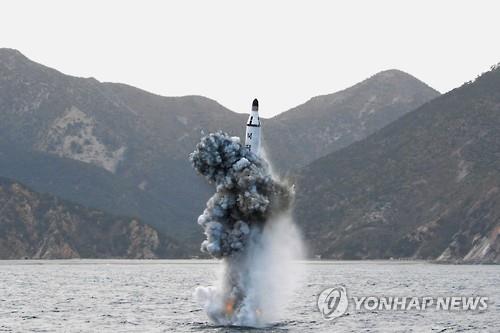- California Assembly OKs highest minimum wage in nation
- S. Korea unveils first graphic cigarette warnings
- US joins with South Korea, Japan in bid to deter North Korea
- LPGA golfer Chun In-gee finally back in action
- S. Korea won’t be top seed in final World Cup qualification round
- US men’s soccer misses 2nd straight Olympics
- US back on track in qualifying with 4-0 win over Guatemala
- High-intensity workout injuries spawn cottage industry
- CDC expands range of Zika mosquitoes into parts of Northeast
- Who knew? ‘The Walking Dead’ is helping families connect
N. Korea test-fires submarine-launched missile: Seoul
SEOUL, Aug. 24 (Yonhap) — North Korea on Wednesday test-fired a submarine-launched ballistic missile (SLBM) in waters off its east coast towards Japan, in an apparent show of defiance against the ongoing military drill between Seoul and Washington, the South Korean military said.
North Korea launched the missile from waters near the eastern port city of Sinpo at around 5:30 a.m., according to South Korea’s Joint Chiefs of Staff (JCS).
The military said that the missile flew about 500 kilometers and fell into waters under Japan’s air defense identification zone. This marked the longest flight by such a missile.
A military source said that the North fired the missile at a very steep angle that affected overall range. He said if it was fired at a regular angle, the missile could have flow more than 1,000 km.
“The SLBM launched earlier in the day indicated (technical) improvements compared with the North’s previous tests,” the JCS said. “It seemed to be aimed at raising military tension in response to the ongoing joint military drill between Seoul and Washington.”
Tensions are running high on the divided peninsula as North Korea threatened on Monday to wage a “pre-emptive nuclear strike” on South Korea and the United States against the allies’ annual military exercise.
Seoul and Washington on Monday kicked off an annual two-week joint military drill involving about 75,000 troops. North Korea has long denounced the joint drill as a rehearsal for a northward invasion, a charge denied by Seoul and Washington.

This photo carried by North Korea’s state media shows North Korea’s April firing of a submarine-launched ballistic missile (SLBM). The South Korean military said on Aug. 24, 2016, that North Korea test-fired an SLBM in waters off its east coast, which flew about 500 kilometers.
Wednesday’s launch marked the sixth time that North Korea has tested its SLBM capabilities after its first attempt in May 2015. It also marked the third SLBM test launch this year.
Local analysts said the latest missile launch can be viewed as a success. In the past, North Korea claimed the successful launching of its SLBM, but outside experts countered that the country was actually only conducting ejection tests to see if the missile could be fired from under the sea.
North Korea has often made missile provocations ahead of or during the Seoul-Washington drill, but this year, inter-Korean tension has further flared up following the latest defection by a senior North Korean diplomat and the decision to deploy an advanced U.S. missile defense system in South Korea.
Thae Yong-ho, a minister at the North Korean embassy in London, recently defected to South Korea, making him one of the highest ranking North Korean officials to do so.
President Park Geun-hye said Monday that possible unrest in Pyongyang can take place amid signs of serious “cracks” in the repressive country.
“North Korea seems to be strengthening internal solidarity by shifting people’s attention to the Seoul-Washington military drill away from Thae’s defection,” said Yang Moo-jin, a professor at the University of North Korean Studies.
In July, Seoul and Washington decided to place the Terminal High Altitude Area Defense (THAAD) on South Korean soil by the end of 2017 in a bid to counter North Korea’s evolving nuclear and missile threats.
Experts said that if the North succeeds in firing off an SLBM, it would make it difficult for the THAAD system to intercept a missile launched by North Korea as the missile can be launched underwater anywhere near the South.
The South Korean military has expected North Korea to be able to deploy SLBMs for combat use within two or three years, but local experts said that the Wednesday launch could enable the North to move the deployment to as early as 2017.
“The SLBM, which flew about 500 km, can be evaluated as a success,” said Moon Keun-sik, an expert at the Korea Defense and Security Forum. “The North could seek to develop a large submarine capable of carrying 12 SLBMs.”
Since North Korean leader Kim Jong-un took office in late 2011, North Korea is believed to have test-fired more than 30 ballistic missiles, including six intermediate Musudan ballistic missile, which theoretically can fly as far as the U.S. territory of Guam.
The South Korean military said that the SLBM is estimated to be capable of flying more than 2,000 km.
It said the launch showed technical progress being made by the North, but added that if deployed, a THAAD missile can intercept it.
North Korea is banned from developing ballistic missile technology under relevant United Nations Security Council (UNSC) resolutions. The UNSC slapped its toughest sanctions on North Korea over its fourth nuclear test in January and long-range rocket launch in the following month.
North Korea has claimed technological breakthroughs in its nuclear and missile programs, saying that it has succeeded in developing a nuclear warhead small enough to be put on a missile. Seoul and Washington have been skeptical about the North’s claims.
Pyongyang is seeking to develop a nuclear-tipped intercontinental ballistic missile capable of hitting targets on the U.S. mainland.
The North has conducted tests of missile re-entry technology and solid fuel rocket engines. Uses of solid propellants for its rocket engine can make it easier for the North to swiftly launch missiles, experts said.
A military source said that North Korea is projected to have used solid fuel to launch the SLBM earlier in the day, but it did not appear to have tested a nuclear warhead detonator.
South Korea strongly condemned North Korea’s missile launch, warning that the North’s obsession with nuclear weapons development will only hasten the country’s self-destruction.
The top diplomats of South Korea, China and Japan on Wednesday vowed to spearhead global efforts against North Korea’s missile provocations when they held a trilateral meeting in Japan.
The North’s provocation came one day before the first anniversary of the two Koreas’ clinching of a rare agreement aimed at easing military tension.
“North Korea should think about the meaning of the Aug. 25 deal. It should suspend its nuclear and missile provocations and take sincere actions (toward denuclearization),” Jeong Joon-hee, a spokesman at Seoul’s unification ministry, told a regular press briefing.













Younghyun Kim
August 26, 2016 at 1:20 AM
As we human beings are aware, if not for bigotry + inhumane inferior species + heinous military regime why Kim Jongun and all his sycophants or bootlickers should change themselves and reflect on their owns. Needless to say, the whole countries and all world innocent people must refer those all bad guys to “the International Court of Justice”, which shall be the prinicpal judicial organ of the United States.
This weak and uneducated korean worldling wants to put all your korean people in mind of following’s remarks “like” all your South Koreans have come to learn the heavy toll that must be paid when they failed to grasp the korean peninsula situations and make its proper preparations. Needless to say, your South Korea must not neglect to correct it.
The worst’s tyrannical military regime was struggling to avoid their encirclement or isolation from our international society since those vicious groups were in the mire or in a hole. Your South Korea must not be very simple to be taken in by the mad regime’s glib dialogue proposal. As we know, those same bad guys were always against world peace and justice at the rear. Don’t forget that. Good luck!
2016. 08. 26. in Suwon, Seoul and at East Sea from Younghyun Kim